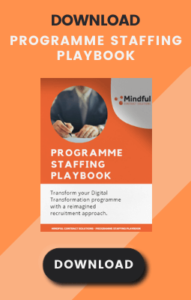Change in an organisation is vital. Not only for growth, but for survival too. But let’s face it, change is rarely easy. In fact, it can be very stressful for people in the organisation.
With the new rules surrounding off-payroll legislation, one such change is that organisations are now contemplating a drastic change on their IR35 policy.
With the help of the Change Curve, we talk through the process of transitioning an outside IR35 workforce to a stricter regime where a large proportion of workers are deemed inside IR35.
By the end of this blog post, you’ll learn what the Change Curve is and how it can be used to assist a significant change programme.
What does Inside IR35 mean?
HMRC introduced the off-payroll working rules (IR35) in 2000. The rules make sure that workers pay broadly the same tax and National Insurance contributions as employees. This means that if a contract is inside IR35, you have to pay income tax and National Insurance contributions.
From 6 April 2021 the way the rules are applied changed. All public sector authorities and medium and large-sized private sector clients are now responsible for deciding if the rules apply.
As a result, many public and private sector organisations have transitioned from an outside IR35 workforce to a stricter regime where a large proportion of workers are deemed inside IR35.
In our blog post, Should I Rule Out Inside-IR35 jobs? we explore why contractors should consider inside-IR35 jobs.
The Change Curve
So, how can organisations successfully incorporate a big change?
We think there is no set formula. However, the Change Curve (as seen below) is a useful 4-stage tool which helps to explain the impact of change, both on individuals and organisations.

Using the Change Curve, we will now explain how you can successfully transition your organisation to an Inside IR35 workforce.
Stage 1 is when the change is first introduced. Transitioning to a stricter regime where most workers are deemed inside-IR35 may be hard for contractors to accept as they will lose a lot of their outside-IR35 privileges. As a result, the initial response may be that of shock or denial.
When the reality of the change hits people, they tend to react negatively. This will push the organisation to Stage 2 of the Change Curve (also known as the “danger zone”). At this stage, there is likely to be lots of disruption to the organisation as this change will be stressful for people. Contractors who may have had years of working outside of IR35 are likely to feel disadvantaged in making the change to inside-IR35 due to the monetary and non-monetary impact.
At Stage 3, people start to explore and understand the changes. They learn how to adapt and don’t view the change in a negative light anymore. Contractors are more likely to accept this change is necessary as the organisation is acting upon a change in legislation.
Contractors will start to embrace the change in Stage 4. They will reorganise their way of working and fully adapt to the new change. The team will become more productive and efficient, enabling the organisation to grow and be successful.
Using the Change Curve
With knowledge of the Change Curve, you can plan how you’ll minimise the negative impact of the change and help people adapt to it more quickly.
Stage 1 – Transparency is key
The key principles that hirers should adopt at this stage is that of transparency and an acknowledgement that the change may be difficult for contractors to go through. It is not okay to have a blanket decision in which every contractor is deemed inside-IR35.
Blanket assessments are non-compliant and are likely to anger contractors. Instead, contractors should be evaluated on a case-by-case basis with fair assessments. You must then have open and honest communication with contractors to explain their assessment results and answer any questions they may have.
Top tips for Stage 1:
- Evaluate contractors on a case-by-case basis
- Have open and honest conversation
- Be available to answer any questions
Stage 2 – Minimise the depression curve
It is important to minimise the time and depth of the depression of the curve so that change can be implemented as smoothly as possible. You should prepare for stage 2 by considering the impacts and objections that people may have.
Contractors need to be fully supported through this stage. It’s important that any difficult questions are not swept under the carpet. If you deal with the heart of the objections presented to you, it will help you win your contractors’ trust.
Top tips for Stage 2:
- Prepare in advance
- Support your contractors fully
- Deal with the heart of the issue
If you want to find out more about IR35, head over to our blog post, 5 Things You Probably Didn’t Know About IR35 (That You Probably Should).
Stage 3 – Offer support and guidance
At this stage, you should offer lots of support and guidance. The organisation can help contractors make the transition from working outside-IR35 to inside-IR35. For example, they can help with guidance on important decisions that contractors will have to make: such as whether to close down their limited company or make those dormant, choice of umbrella companies, etc.
You should also consider what else you can do as a hirer to make the change more palatable for contractors. This could mean giving a raise or take other non-monetary forms. You should be cognisant of the fact that not everyone will be at stage 3 at the same time. People should be allowed time to accept the change. Implementing strict deadlines is likely to be unhelpful as it will cause unnecessary stress.
Top tips for Stage 3:
- Offer guidance on important decisions
- Consider how to make the change more palatable
- Don’t implement strict deadlines
Stage 4 – Reiterate the benefits
It is important to thank contractors for coming around to accept the changes, as this is genuinely a big deal for them. It’s worth reiterating to all stakeholders how this change will have long term benefits for those involved. All said, moving inside-IR35 means your contractors have a lower risk of HMRC knocking on their doors in the future. The utility of your contractors’ having this peace of mind, is worth a mention.
Also, it is helpful to acknowledge that having an IR35-safe way of operating, means there is more freedom for you as the hirer and your contractors to collaborate. All of this will help create a culture of success and ensure that any future change will be accepted and implemented much more easily.
Top tips for Stage 4:
- Thank contractors for accepting the changes
- Reiterate the benefits of the change
Where do you go from here?
Change in an organisation is necessary, yet there is always an initial period of fear and stress. It is therefore important to be prepared and fully support your people along the way.
Here at Mindful, we can help and support your transition to an inside IR35 workforce.
See our Managed Commercial Services page to see how we can help you today.



